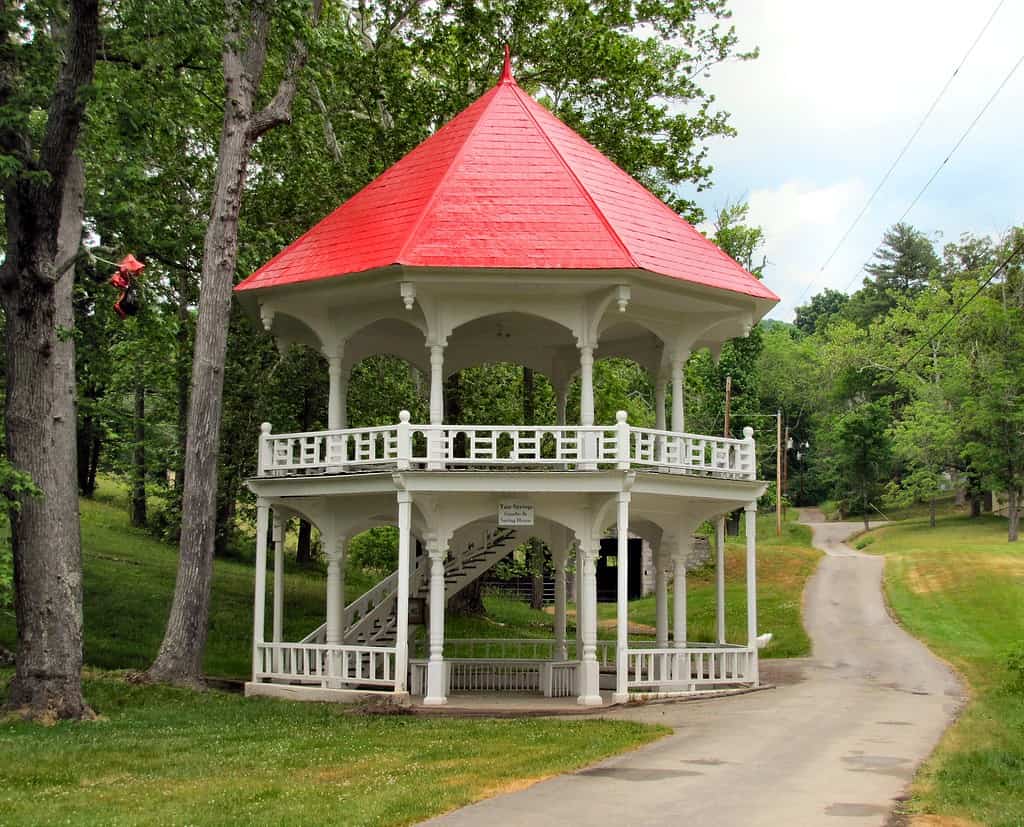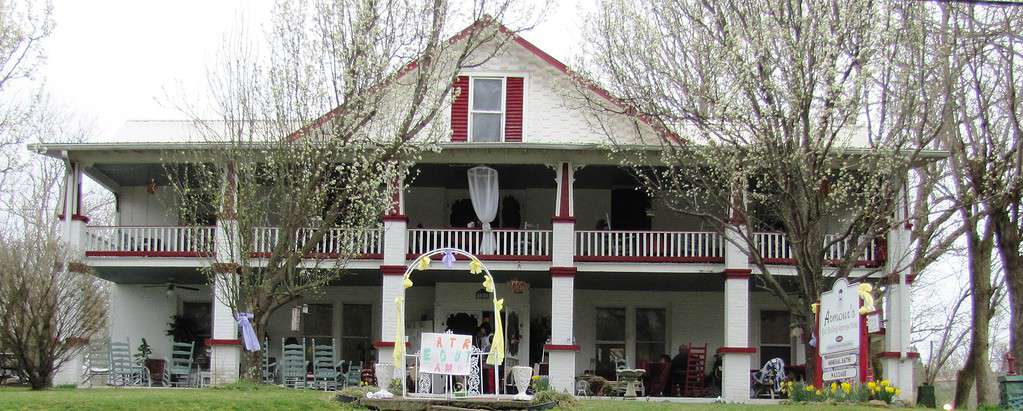Tennessee has no shortage of towns and communities with the word “Springs” in their name. What’s interesting, though, is that finding operational natural springs in Tennessee is hard to come by in the 21st century.
Are there natural springs in Tennessee today? Yes, but only one location still offers mineral waters for public consumption.
Located in Macon County, Red Boiling Springs, TN, was initially named Salt Lick Creek because of a nearby salt lick. A one-and-a-half hour’s drive northeast of Nashville, it is the only location in the state to soak in mineral waters that spring naturally from the area.

Salt Lick Creek near Red Boiling Springs, TN, lent its name to the area before the discovery of the natural springs in Macon County.
Red Boiling Springs
A farmer first noticed red-colored sulfur water coming from the springs on his property in the 1830s. But it wasn’t until 1876 that widespread interest grew in the springs. This was the beginning of hotel resort construction around the springs.
As transportation options expanded, more visitors stayed at the “mineral resorts” through the late nineteenth and early twentieth centuries. Red Boiling Springs saw its peak from the 1920s into the mid-1930s.
Visitors to Red Boiling Springs would “take the waters” for their assumed medicinal benefits. This included drinking the water, as well as bathing in and inhaling steam from them. The water’s predominant mineral was sulfur (with its noticeable odor and taste of rotten eggs). Proponents of the mineral waters claimed they cured a wide variety of illnesses and conditions, including diabetes, rheumatism, and gonorrhea.
Visiting a Natural Spring in Tennessee Today
First built in 1924 as Count’s Hotel, Armour’s Hotel & Spa in Red Boiling Springs, TN, offers guests mineral baths in a house behind the main building. Listed on the National Register of Historic Places, it is the only operational mineral bath spa in Tennessee today.
Other Natural Springs in TN
Red Boiling Springs is not the only town in Tennessee that built mineral resorts around the springs in their communities.
Tennessee’s history is filled with towns that remain “Springs” in name only today. The majority of the natural springs dried up, or they were filled in or covered over in favor of modern advancement.
However, some of the springs (and the communities that bear their names) with the most interesting and noted backgrounds include:
- Primm Springs
- Tate Springs
- Faulkner Springs
Primm Springs in Hickman County, TN
Established in the mid-1830s by the John Primm family, Primm Springs was first known as White Sulphur Springs.
Daniel Estes and his family built three hotels and grew the resort to 30 different structures during the 1860s. Estes himself claimed the waters healed him. His property featured five mineral springs of black and white sulfur, lime (freestone), calomel, and arsenic.
One interesting phenomenon that even Tennessee’s entomologists could not explain was the absence of mosquitoes and flies in the Primm Springs area. (Perhaps the natural springs acted as an insect repellant?)
The Hickman County watering spa flourished well into the 1920s, providing hospitality and entertainment for as many as 500 guests at a time. The resort ultimately failed because the Estes family refused to install electricity (and thus removed several old trees in the area).

A brochure for the Tate Springs Hotel, published in 1925, advertises its mineral water’s health benefits.
Tate Springs in Grainger County, TN
Another renowned hotel and resort is Tate Springs in Bean Station, TN, which is in Grainger County.
Tate Springs shipped its “Tate Epsom Water” all over the world, as it supposedly cured stomach, kidney, and liver ailments.
The Tate Springs Hotel, the first structure erected on the acreage surrounding Tate Springs, became a world-class destination. The Fords, Rockefellers, Firestones, and Studebakers were some of the famous and wealthy who visited there in the early 1900s.
Today, the Tate Springs Springhouse gives a nod to the original mineral spring upon which the resort was founded. It is a two-story Victorian gazebo and is listed on the National Register of Historic Places.

The Tate Springs Springhouse marks a well to the mineral springs from which the renowned “Tate Epsom Water” was drawn.
Faulkner Springs Hotel in Warren County, TN
McMinnville, TN, entrepreneur Clay Faulkner claimed healing from his kidney and bladder problems by the mineral water that sprung from his property in 1897. Shortly thereafter, Faulkner built the Faulkner Springs Hotel and Resort. In 1906, he began shipping the mineral water by rail for $4.00 a barrel (in today’s dollars, that equals approximately $136 a barrel).
What Happened to the Natural Springs in Tennessee?
In addition to these three properties, dozens of other natural springs in Tennessee have similar histories and sad demises. Here are a few more to add to the list — natural springs that were once prominent watering holes, thriving resorts, and travel destinations in Tennessee:
- Oliver Springs in Roane County – The hotel burned in 1905, and the springs were filled in.
- Estill Springs in Franklin County – The hotels were torn down in the 1930s, and the US 41A highway covers the springs.
- Winchester Springs in Franklin County – Tims Ford Lake covers the springs.
- Bon Aqua Springs in Hickman County – The hotel was torn down in the early 1940s, and three of the four springs have dried up.
- Seven Springs in Dekalb County – The hotel closed and then burned in the early 1950s, and gravel covers the springs.
- Jefferson Springs in Rutherford County – Construction of the Percy Priest Lake in the late 1960s dictated all the buildings to be demolished. Percy Priest Lake covers the springs.

Jefferson Springs flows beneath the surface of the water of Percy Priest Lake in Tennessee.
©Mavo Media 360/Shutterstock.com
Natural Springs in Tennessee Birthed Tourism in the State
Sources of water were always a sensible place for people to gather and establish community. Natural springs in Tennessee were no exception. They provided clean water for drinking, cooking, and bathing. When many touted the waters’ healing properties, it’s not surprising people flocked to these locations to get in on the latest fix for their ailments, too.
For Tennessee, these natural springs provided something else: the birth of the tourism and hospitality industries. These mineral water resorts were the precursors to today’s $24 billion tourism industry in the state, which is also the state’s third largest employer.
Summary of Natural Springs That Are and Once Were in Tennessee
| Number | Natural Springs | Location | Still Exists? |
|---|---|---|---|
| 1 | Red Boiling Springs | Macon County | Yes |
| 2 | Primm Springs | Hickman County | No, town name only |
| 3 | Tate Springs | Grainger County | No, town name only |
| 4 | Falkner Springs | Warren County | No, town name only |
| 5 | Oliver Springs | Roane County | No, the springs were filled in |
| 6 | Estill Springs | Franklin County | No – US 41A Highway covers the springs |
| 7 | Winchester Springs | Franklin County | No – Tim Ford Lake covers the springs |
| 8 | Bon Aqua Springs | Hickman County | 3 out of 4 springs have dried up |
| 9 | Seven Springs | Dekalb County | No – gravel covers the springs |
| 10 | Jefferson Springs | Rutherford County | Percy Priest Lake covers the springs |
Thank you for reading! Have some feedback for us? Contact the AZ Animals editorial team.









